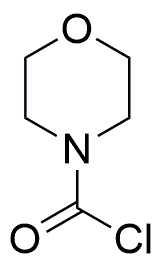4-Morpholinylcarbonyl chloride is widely utilized in research focused on:
- Synthesis of Pharmaceuticals: This compound serves as an important intermediate in the production of various pharmaceuticals, particularly those targeting central nervous system disorders. Its ability to form stable linkages enhances drug efficacy.
- Polymer Chemistry: It is used in the development of specialty polymers, where it acts as a reactive monomer. This application allows for the creation of materials with tailored properties for specific industrial uses.
- Agrochemicals: The compound plays a role in synthesizing agrochemicals, including herbicides and insecticides, contributing to more effective pest control solutions in agriculture.
- Bioconjugation: In biochemistry, it is utilized for bioconjugation processes, enabling the attachment of biomolecules to surfaces or other compounds, which is vital for drug delivery systems and diagnostic applications.
- Research Reagents: It serves as a reagent in various chemical reactions, aiding researchers in the development of new compounds and materials, thus advancing scientific knowledge and innovation.
General Information
Properties
Safety and Regulations
Applications
4-Morpholinylcarbonyl chloride is widely utilized in research focused on:
- Synthesis of Pharmaceuticals: This compound serves as an important intermediate in the production of various pharmaceuticals, particularly those targeting central nervous system disorders. Its ability to form stable linkages enhances drug efficacy.
- Polymer Chemistry: It is used in the development of specialty polymers, where it acts as a reactive monomer. This application allows for the creation of materials with tailored properties for specific industrial uses.
- Agrochemicals: The compound plays a role in synthesizing agrochemicals, including herbicides and insecticides, contributing to more effective pest control solutions in agriculture.
- Bioconjugation: In biochemistry, it is utilized for bioconjugation processes, enabling the attachment of biomolecules to surfaces or other compounds, which is vital for drug delivery systems and diagnostic applications.
- Research Reagents: It serves as a reagent in various chemical reactions, aiding researchers in the development of new compounds and materials, thus advancing scientific knowledge and innovation.
Documents
Safety Data Sheets (SDS)
The SDS provides comprehensive safety information on handling, storage, and disposal of the product.
Product Specification (PS)
The PS provides a comprehensive breakdown of the product’s properties, including chemical composition, physical state, purity, and storage requirements. It also details acceptable quality ranges and the product's intended applications.
Certificates of Analysis (COA)
Search for Certificates of Analysis (COA) by entering the products Lot Number. Lot and Batch Numbers can be found on a product’s label following the words ‘Lot’ or ‘Batch’.
*Catalog Number
*Lot Number
Certificates Of Origin (COO)
This COO confirms the country where the product was manufactured, and also details the materials and components used in it and whether it is derived from natural, synthetic, or other specific sources. This certificate may be required for customs, trade, and regulatory compliance.
*Catalog Number
*Lot Number
Safety Data Sheets (SDS)
The SDS provides comprehensive safety information on handling, storage, and disposal of the product.
DownloadProduct Specification (PS)
The PS provides a comprehensive breakdown of the product’s properties, including chemical composition, physical state, purity, and storage requirements. It also details acceptable quality ranges and the product's intended applications.
DownloadCertificates of Analysis (COA)
Search for Certificates of Analysis (COA) by entering the products Lot Number. Lot and Batch Numbers can be found on a product’s label following the words ‘Lot’ or ‘Batch’.
*Catalog Number
*Lot Number
Certificates Of Origin (COO)
This COO confirms the country where the product was manufactured, and also details the materials and components used in it and whether it is derived from natural, synthetic, or other specific sources. This certificate may be required for customs, trade, and regulatory compliance.


